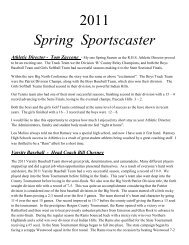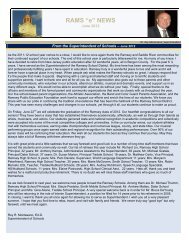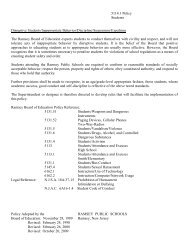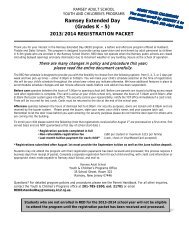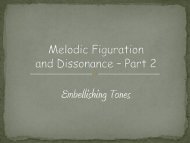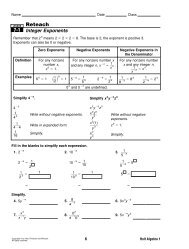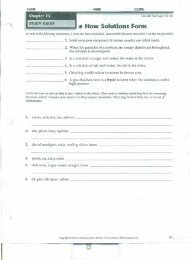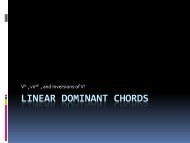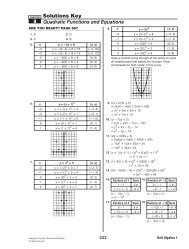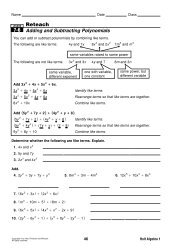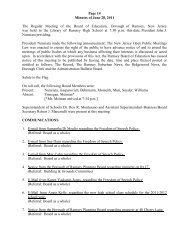Pre-Algebra Chapter 6 - Ramsey School District
Pre-Algebra Chapter 6 - Ramsey School District
Pre-Algebra Chapter 6 - Ramsey School District
You also want an ePaper? Increase the reach of your titles
YUMPU automatically turns print PDFs into web optimized ePapers that Google loves.
Standardized<br />
Test Practice<br />
Extending<br />
the Lesson<br />
49. CRITICAL THINKING Marty and Spencer each saved money earned from<br />
shoveling snow. The ratio of Marty’s money to Spencer’s money is 3:1. If<br />
Marty gives Spencer $3, their ratio will be 1:1. How much money did<br />
Marty earn?<br />
50. WRITING IN MATH Answer the question that was posed at the beginning<br />
of the lesson.<br />
How are ratios used in paint mixtures?<br />
Include the following in your answer:<br />
• an example of a ratio of blue to yellow paint that would result in a<br />
darker shade of green, and<br />
• an example of a ratio of blue to yellow paint that would result in a<br />
lighter shade of green.<br />
51. Which ratio represents the same relationship as for every 4 apples, 3 of them<br />
are green?<br />
A 9:16 B 3:4 C 12:9 D 6:8<br />
52. Joe paid $2.79 for a gallon of milk. Find the cost per quart of milk.<br />
A $0.70 B $1.40 C $0.93 D $0.55<br />
53. Many objects such as credit cards or<br />
phone cards are shaped like golden<br />
rectangles.<br />
a. Find three different objects that are<br />
close to a golden rectangle. Make a<br />
table to display the dimensions<br />
and the ratio found in each object.<br />
A golden rectangle is a<br />
rectangle in which the<br />
ratio of the length to the<br />
width is approximately<br />
1.618 to 1. This ratio is<br />
called the golden ratio.<br />
.<br />
b. Describe how each ratio compares to the golden ratio.<br />
c. RESEARCH Use the Internet or another source to find three places<br />
where the golden rectangle is used in architecture.<br />
Maintain Your Skills<br />
Mixed Review<br />
State whether each sequence is arithmetic, geometric, or neither. Then state<br />
the common difference or common ratio and write the next three terms of<br />
the sequence. (Lesson 5-10)<br />
54. –3, 6, –12, 24, … 55. 12.1, 12.4, 12.7, 13, …<br />
ALGEBRA Solve each equation. (Lesson 5-9)<br />
56. 3.6 x – 7.1 57. y 3 4 2 3 58. 4.8 6z 59. 3 8 w 5<br />
60. Find the quotient of 1 1 7 and 4 . (Lesson 5-4)<br />
7<br />
Write each number in scientific notation. (Lesson 4-8)<br />
61. 52,000,000 62. 42,240 63. 0.038<br />
Getting Ready for<br />
the Next Lesson<br />
64. Write 8 (k 3) · (k 3) using exponents. (Lesson 4-2)<br />
PREREQUISITE SKILL Solve each equation.<br />
(To review solving equations, see Lesson 3-4.)<br />
65. 10x 300 66. 25m 225 67. 8k 320<br />
68. 192 4t 69. 195 15w 70. 231 33n<br />
268 <strong>Chapter</strong> 6 Ratio, Proportion, and Percent



